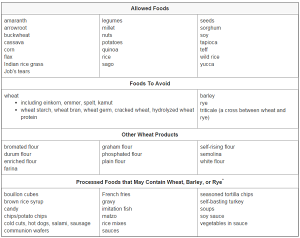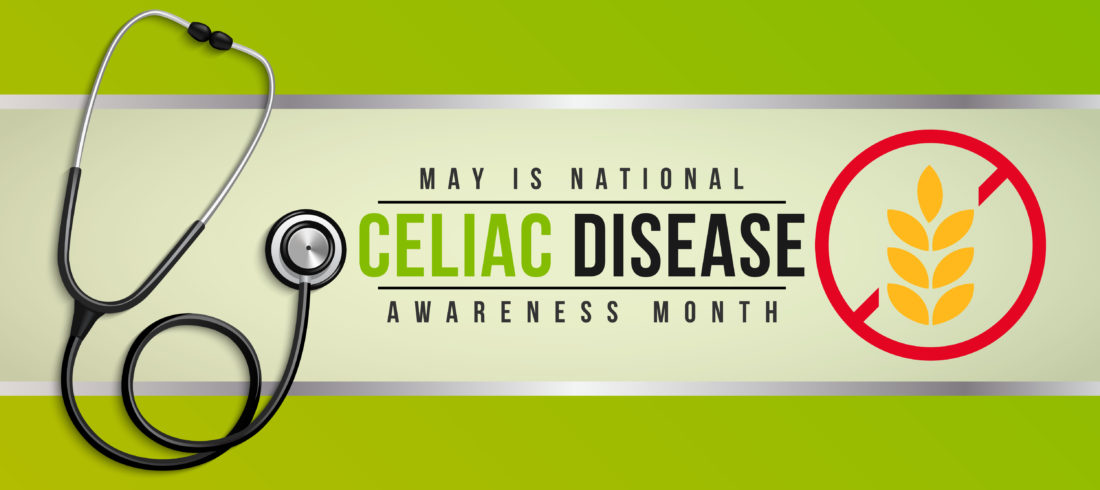What is Celiac Disease?
Celiac Disease (CD) is a chronic inflammatory disease of the small intestine that interferes with absorption of nutrients from food. People with CD can’t tolerate gluten, a protein found in wheat, rye, and barley. Gluten is found mainly in foods but may also be found in everyday products such as medicines, vitamins, and lip balms. When they do consume gluten, their immune systems respond by damaging or destroying the villi—tiny fingerlike protrusions lining the small intestine—which normally allow nutrients to be absorbed through the walls of the small intestine into the bloodstream. Without healthy villi, a person becomes malnourished, no matter how much food he or she consumes.
Celiac Disease was once thought to be a rare childhood syndrome, but is now recognized as a common genetic disorder that can first appear at any age. About 5-10 percent of people who have a first-degree relative diagnosed with CD— a parent, sibling, or child—is likely to have it as well. In the U.S., it’s estimated that close to 3 million (over 10%) people have CD, but the majority haven’t been diagnosed.
What causes Celiac disease?
Long term Celiac Disease can cause complications, including malnutrition, leading to anemia, osteoporosis, miscarriage, liver disease, and cancers of the intestines, especially lymphoma.The cause for Celiac Disease is an allergy to gluten, a protein found in wheat and other grains. When people with celiac Disease eat foods or use products containing gluten, their immune system responds by damaging or destroying villi—the tiny, fingerlike protrusions lining the small intestine. Villi allow nutrients from food to be absorbed through the walls of the small intestine into the bloodstream, without healthy villi, people can become malnourished, no matter how much food they eat. Foods containing wheat, barley, triticale or rye contain the gluten that is harmful to people with Celiac Disease. The best examples are breads, crackers, and pasta.
What are the symptoms of Celiac Disease?
Symptoms of Celiac Disease vary from person to person and recognizing Celiac Disease can be difficult because some of its symptoms are similar to those of other diseases. CD can be confused with IBS (irritable bowel syndrome),inflammatory bowel disease, diverticulitis, intestinal infections, and chronic fatigue syndrome. Symptoms also vary depending on a person’s age and the degree of damage to the small intestine. Some people go years before a CD diagnosis is made accurately, and unfortunately the longer left untreated, the greater the chance of developing long-term complications. The National Institute of Health has launched a Celiac Disease Awareness Campaign and, as doctors are alerted to the many varied symptoms of the disease, diagnosis rates are increasing.
Adults are less likely to have digestive symptoms and may instead have one or more of the following:
- unexplained iron-deficiency anemia
- arthritis
- tingling numbness in the hands and feet
- seizures
- fatigue
- missed menstrual cycle
- bone or joint pain
- depression or anxiety
- infertility or multiple miscarriages
- canker sores in mouth
- bone loss (osteoporosis)
- itchy rash
Children and infants with CD show more digestive symptoms than adults. They include but are not limited to:
- abdominal bloating and pain
- chronic diarrhea
- vomiting
- constipation
- pale, foul-smelling, or fatty stool
- weight loss
- irritability
- delayed growth and development due to lack of nutrition
- delayed puberty
- dental enamel defects of permanent teeth
How is Celiac Disease diagnosed?
Recently-developed blood tests are making the process easier. People with Celiac Disease have a higher than normal levels of certain autoantibodies—proteins that react against the body’s own cells or tissues—in the blood. If blood tests and symptoms suggest CD, endoscopy is used to perform a biopsy of the small intestine and confirm the diagnosis by checking for damage to the villi.Recognizing Celiac Disease can be difficult because some of its symptoms are similar to those of other diseases. Celiac Disease can be confused with irritable bowel syndrome, iron-deficiency anemia caused by menstrual blood loss, inflammatory bowel disease, diverticulitis, intestinal infections, and chronic fatigue syndrome. As a result, Celiac Disease has long been underdiagnosed or misdiagnosed. As doctors become more aware of the many varied symptoms of the disease and reliable blood tests become more available, diagnosis rates are increasing.
Before testing, you should continue to eat foods containing gluten, such as breads and pastas. If you stop consuming gluten in advance, the results may be negative for celiac disease even if the disease is present.
Intestinal Biopsy
If blood tests and symptoms suggest celiac disease, a biopsy of the small intestine is performed to confirm the diagnosis. A tiny piece of tissue is removed from the small intestine to check for damage to the villi. This is done through a procedure called an endoscopy. (link)
Dermatitis Herpetiformis
About 15-25 percent of people who have CD show it with an intensely itchy blistering skin rash. The rash usually occurs on the elbows, knees, and buttocks. Most people with this type of skin rash actually have no other digestive symptoms of celiac disease. This is called DH (dermatitis herpetiformis), and is diagnosed with blood test and a skin biopsy. The skin disease will respond to a gluten-free diet. Your doctor may also prescribe antibiotics such dapsone.
Screening
If a family member has CD and you suspect the disease you may want to be screened. Four to 12 percent of an affected person’s first-degree relatives will also have the disease. Screening is done by testing for the presence of autoantibodies in the blood in people without symptoms.
How is Celiac Disease treated?
Currently, the only treatment for celiac disease is a gluten-free diet. For most people, this diet will stop symptoms, heal existing intestinal damage, and prevent further damage. Improvement begins within days of going gluten-free. A dietitian or nutritionist can help a new patient learn how to read ingredients and identify foods that contain gluten.Treatments
To stay well, people with celiac disease must avoid gluten for the rest of their lives, as even a small amount can damage the small intestine. The damage can occur without noticeable symptoms. Depending on age, severity of damage, some symptoms may not improve such as dental enamel defects.
Luckily, CD sufferers are not alone; these days, supermarket shelves bulge with gluten-free products, restaurants rise to the challenge of providing tasty alternatives, and your physician can help you eat your way to good health.
For most people, following this diet will stop symptoms, heal existing intestinal damage, and prevent further damage. Children tend to heal must faster, in 3-6 months, while in adults it can take several years. When your intestine is healed, it means you now have villi that can absorb nutrients from food into the bloodstream.
For some people, even the gluten-free diet does not show improvement of symptoms. This is generally because somehow, small amounts of gluten are still getting into the system. These hidden sources of gluten include additives such as modified food starch, preservatives, and stabilizers made with wheat. Many corn and rice products are manufactured in the same factories as wheat products, therefore contaminating the product you are eating.
Refractory Celiac Disease occurs when the intestines are too severely damaged and cannot heal. These people may need to get their nutrients directly into their bloodstream intravenously (through a vein). Researchers are evaluating drug treatments. Steroids are frequently used in such people.
Gluten-free Diet
You can still eat a well-balanced diet despite these restrictions. Use potato,rice, or rice flour when baking and cooking, and buy gluten-free bread, pasta, and other products from stores that carry organic foods, or order products from special food companies.A gluten-free diet means not eating foods that contain wheat, rye, and barley. The foods and products made from these grains should also be avoided. In other words, a person with celiac disease should not eat most grain, pasta, cereal, and many processed foods.
Plain meats, fish, fruits, and vegetables do not contain gluten. Oats can be used as long as the oats are not contaminated with wheat gluten during processing. Learning to eat a gluten-free diet can be a challenge at first, but once you get used to reading the product labels, you should do just fine. When in doubt, stay away from the item and when eating out, ask you waiter or chef about the ingredients.
Sometimes gluten is used medications, so it’s important to communicate with your pharmacist. Also be careful of other products such as lipsticks and play dough. Below is a table of allowed foods and foods to avoid.

* Most of these foods can be found gluten-free. When in doubt, check with the food manufacturer.
*source National Digestive Diseases Information Clearinghouse (NDDIC)

